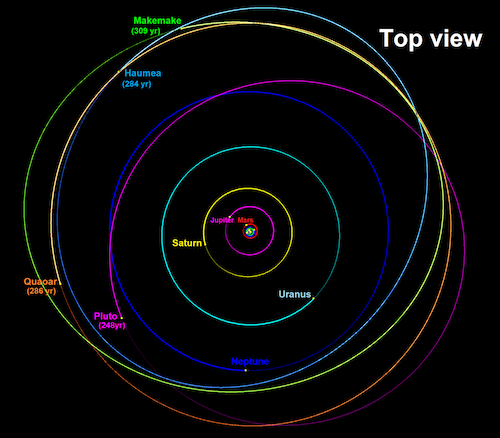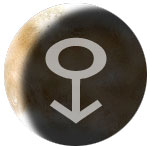Trans-Neptunian Planets
 A Trans-Neptunian Planet is any minor planet or dwarf planet in the Solar System that orbits the Sun at a greater average distance than Neptune. In modern astronomy, Pluto is considered a Trans-Neptunian dwarf planet, while astrologers still consider Pluto a major planetary body of deep psychological significance. Eris is the same size and category, and is brighter and more massive than Pluto, so that it is likely to have astrological significance as well, as do perhaps the other named 'dwarf' planets in the Kuiper Belt, namely Haumea and Makemake. All this is currently being developed and explored. Please see The Tenth Planet by Henry Seltzer, and Seltzer's article in the April 2020 issue of The Mountain Astrologer for more information. Henry and his son Asia designed the symbol for Eris that is now in popular use.
A Trans-Neptunian Planet is any minor planet or dwarf planet in the Solar System that orbits the Sun at a greater average distance than Neptune. In modern astronomy, Pluto is considered a Trans-Neptunian dwarf planet, while astrologers still consider Pluto a major planetary body of deep psychological significance. Eris is the same size and category, and is brighter and more massive than Pluto, so that it is likely to have astrological significance as well, as do perhaps the other named 'dwarf' planets in the Kuiper Belt, namely Haumea and Makemake. All this is currently being developed and explored. Please see The Tenth Planet by Henry Seltzer, and Seltzer's article in the April 2020 issue of The Mountain Astrologer for more information. Henry and his son Asia designed the symbol for Eris that is now in popular use.
Eris

Keyword: Feminine Warrior for Soul Purpose
If we take a look at the mythology of the newest planet in our Solar System (even though they are calling her a dwarf) and the events surrounding her discovery, from 2003 - 2006, the idea of potentially violent struggle is indeed paramount and as well the ideal of the vital female warrior. Before being officially named Eris last fall, after the Goddess of Strife and Discord, the new planet, designated 2003 UB313, was called Xena, and the name Persephone was considered. Since Persephone and Xena, the warrior princess of popular culture, are involved in the early naming of Eris, the archetypal image comes to the fore of a perhaps damaged and certainly militant feminism that does not shrink from violence. As for events, the time frame of the discovery matches that of the Iraq War, which can certainly be viewed as a violent struggle for resources.
When Pluto was found in the 1930's, its discovery introduced some dark notions regarding the human condition, of a depth and a power that were previously unacknowledged. It stands to reason that Eris, found even farther out into the dark void at the edge of the solar system, will also. Just as we have grown through our understanding of the astrological Pluto, so too we will grow as we come to integrate the Eris archetype into modern Western Astrology.
The astrology of Eris seems to be related to the no-holds-barred fight for continued existence that is fundamental in all natural process, and for making a stand for what one believes, even if violence is involved. As the sister of Mars, the God of War, Eris willingly sought the battle. There is a side of nature that is quite harsh, a struggle for survival, and this struggle is a fundamental part of the human condition as well, for we are still half animal. Nature can be viewed in a rosy light, as it was in the hippie movement of the sixties, Bambi drinking from a little stream, but underlying this beauty is the possibility of sudden death at any moment since all of nature's children need to eat. Eris is related to this principle, and to the concept of the female warrior that embodies it, and especially to the feminist struggle for rights in a patriarchal society.
See also: Personalized Eris Report, Eris Resources, Historical Survey of Eris
Makemake
Keyword: Earth Issues
This is the second new planet, or dwarf planet, or "plutoid," to be officially named, after being referred to as "Easter bunny" for three years by its discoverer, Mike Brown. The official name refers to the creation god of Easter Island, or Rapa Nui. In size somewhat smaller than either Pluto or Eris, this planet follows a new 21st century tradition of naming discovered planets from the creation deities of indigenous peoples, rather than more classically from the Greco-Roman pantheon of gods and goddesses. The orbital period of Makemake is 306 years. Like Eris, Makemake was discovered near the farthest point of its highly elliptical orbit, and incidentally in an exact inconjunct or 150-degree aspect from Eris within 2 minutes of a degree of longitude.
As the creation god of the Rapa Nui, Makemake symbolizes a connection with environmental sagacity that is entirely appropriate for the troubled earth times, including environmental issues, surrounding its discovery. This is because when Europeans discovered what became known as Easter Island, the Rapa Nui occupied an island entirely denuded of its trees, either because they were cut down or lost to disease, and in their isolated island environment could no longer build canoes or fish and were living a subsistence existence. Of course this island culture is also famous for the multitude of incredibly large stone heads that were carved and erected there, having been transported to the shoreline. The myth involving their creation god Makemake includes a form of worship in which a Birdman was selected from tribal leaders each year. The claimants would select a representative from the best of the young warriors, who would compete by swimming to a neighboring islet, a dangerous journey that involved climbing a large cliff on their return wearing a headdress designed for the purpose of fetching the first bird egg of the season back to the spring festival at the top. Once his champion returned victorious, the selected Birdman for that year would become a powerful shamanic figure, and would meditate and have the big dreams to guide the people and bring his visions to the culture. Makemake is thus a male God, yet with a strong intuitive component.
Taking this segment of ritual practice as an indication of this new planetary energy, we could speculate that the archetype associated with Makemake involves delving down into the dark interior of the psyche in order to obtain a form of received wisdom to be merged with the warrior male outer-oriented energy of the ego. This wisdom can only be found in the inner world, a world that is also connected to Nature and natural process, to natural law, right action, right relationship, and to an internal moral compass, resulting in activism for furthering the culture's evolution. Where he is found in charts there can be found also Earth wisdom and the capacity for spiritual renewal.
The astrology of Makemake is related to love and care for the natural world and for defending Earth's environment. This archetype thus signals a profound connection to nature that is quite similar to the archetype of Haumea, his fellow traveler in the Kuiper Belt, with the same astronomical designation and also named from the pantheon of indigenous gods and goddesses. Indeed, these two are possessed of quite similar orbital periods, being only a little longer than their far better understood cousin, Pluto. They travel around the Zodiac in recent centuries with Haumea leading by a separation of 20 to 40 degrees. As the male God of the pair, and seemingly the more militant of the two, Makemake is associated with the wisdom of the natural world, and also with an activist stance for advancing important environmental and social issues that are highlighted in this 21st century.
Haumea
Keyword: Earth Goddess
The third trans-Neptunian Object, or TNO, to be officially designated as a dwarf planet, after Eris and MakeMake, Haumea was discovered just after Christmas 2004 and nicknamed "Santa" by discoverer Mike Brown's team before being named for the Hawaiian creation goddess. Its discovery was officially announced on July 29th, 2005, by his group. Haumea is different from other TNOs in that it is rocky, as befits a goddess of the earth, and rotating extremely rapidly - a revolution every 4 hours. As a result, its shape is elongated, like a small cigar. Haumea's extreme elongation makes it unique among TNOs, with its greatest axis twice as long as its shortest. Its orbital period is 284 years. It was discovered when it was near to its farthest distance from the Sun, or its aphelion, as were MakeMake and Eris.
Creation goddess of the islands of Hawaii, Haumea was the source of many gods and goddesses as well as of the race of humankind. Pele, Hi'iaka, Namaka, Laka and many others were her offspring. Her skill at childbirth is recounted in countless stories. Children sprang from different parts of her body, Hi'iaka from her mouth and Namaka from her breasts. She rules over fertility and childbirth. She possessed a magic stick from the Makalei tree that would enable her to conjure up fish and other edibles, and therefore she is also associated with a never-failing food supply. She also has the power of eternal youth. With each birth she was destroyed and subsequently recreated herself. This choice of planetary archetype arising in these times would seem to support the environmental concerns of dwindling resources and the response of fecund creativity that gives forth abundance and life itself in response to deprivation.
The astrology of Haumea is related to love of the natural world and to the fecundity of natural process. This archetype thus signals profound connection to Nature, implying connection to Source, and as well to natural law, to right action, right relationship, and truth-telling. When strongly placed, those natives also frequently display a form of natural charisma. It may well develop that this planetary archetype comes to represent the power of life to triumph over adversity by drawing upon inner respect and understanding of Nature herself, and for an innate moral compass that all of us possess, but do not always act upon. Where she is located in the chart will be a source of inner strength, spiritual connection, and protean flexibility.